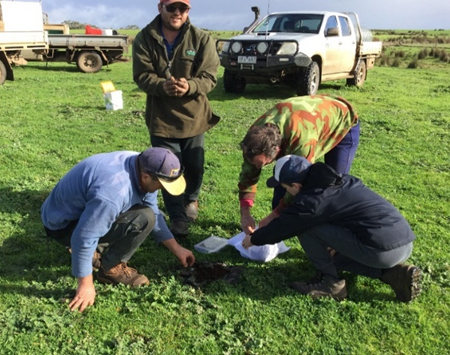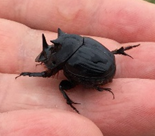Demonstrating the benefits of dung beetles for prime lamb enterprises – Enhanced Producer Demonstration Site
Download a printable version of this page: Demonstrating the benefits of dung beetles for prime lamb enterprises ![]() [PDF File - 958.8 KB]
[PDF File - 958.8 KB]
Producers: Keiller family, ‘Cashmore Park’
Location: Cashmore – 10 km west of Portland
Property size: 1600 ha
Soils: sand, sandy loam, clay loam
Rainfall: 830 mm
Enterprises: Prime and feeder lambs, seedstock rams, breeding ewes, store cattle
Dung beetles have been the focus of on-farm demonstrations that are underway within the South West Prime Lamb Group (SWPLG). Despite a wealth of cattle related research, there is limited completed on dung beetles in sheep production systems.
The group established an Enhanced Producer Demonstration Site (EPDS), co-funded by Agriculture Victoria and Meat & Livestock Australia (MLA) and sought support through the Dung Beetle Ecosystem Engineers (DBEE) project.
Johno, Brigita and Dean Keiller hosted dung beetle demonstrations on their property ‘Cashmore Park’ near Portland. The Keillers were interested in the nutrient cycling qualities of dung beetles and had released several colonies around ten years ago to establish more species on their farm.
Establishing what’s out there
Cashmore Park was one of eight farms to undertake monthly trappings, with an aim of identifying what beetles are active on sheep dung at different times of the year, and a focus on the seasonal gaps that could be filled by introducing various beetle species.
Nine species were found on Cashmore Park, including six introduced and three native species. A further two species were found on other group members’ properties. Onthophagus taurus was the most commonly trapped beetle, found from late spring to autumn in large numbers. O. taurus is a small, introduced beetle, but in the large numbers observed at Cashmore Park, they’re capable of shredding dung pats within a day, making them valuable for cleaning pastures and cycling nutrients.
The three-horned dung beetle, Onthophagus mnisznechi (Fig. 1), was also found in good numbers throughout the year. This native species evolved to feed on the coarse, pellet-like droppings of marsupials and was previously dismissed as a non-dung burier. However, it has proven to be adapting to livestock dung with dung-filled tunnels observed to a depth of 20cm.

Most of the species trapped at Cashmore Park are active over the warmer months, with a noticeable gap in abundance observed in winter and early spring. To help bridge that gap, Johno has selected three winter-active species (Onthophagus vacca, Bubas bison and Copris hispanis) and has established on-farm dung beetle nurseries to breed up populations for release.
Benefits for soil fertility
The Keillers also hosted dung burial trials to demonstrate and measure changes in soil fertility from the action of the winter-active species Bubas bison on three different soil types. Bubas bison is one of the four deep tunneling dung beetles found in Australia and is known to bury dung to 60cm. The trial compared 50x50 cm plots of Dung+Beetles, Dung Only and Control (no dung or beetles). Five kilograms of sheep dung was added over ten weeks to the Dung+Beetle and Dung Only plots, and 15 pairs of B. bison were added to the Dung+Beetle plots. Spare plots were excavated in spring to observe the action of dung beetles, and soil testing was undertaken across treatments the following winter at 0-10, 10-30 and 30-60cm.
Figures 2-6 show the excavated plots including dung tunnels approximately 40 cm long and around 2.5 cm across found beneath the beetle plots, with egg chambers at the base. Large numbers of earthworms were found under the plots and wrapped around the dung tunnels and plant roots had clearly travelled down the soil profile through dung tunnels.





Soil testing showed that the burial action of dung beetles had increased phosphorus (Olsen P) and potassium (Colwell K) to depth (Figs. 7 and 8). Dung Only plots had the highest surface phosphorus and potassium levels, however dung beetles had mobilised nutrients moving them down the soil profile into the 10-30 and 30-60 cm.
We would expect that the tunnelling activity from dung beetles and the increased nutrient levels at depth drives plant roots further down the soil profile, allowing them to access moisture from deeper down. This action could potentially increase the growing season, with removal of dung from the surface also reducing pasture fouling and the potential for nutrient runoff.


Next steps
Whilst these demonstrations have finished, the SWPLG are continuing involvement with dung beetles and recently began a project investigating the effects of drenches and the development of drench tolerance within dung beetle populations.
As for Cashmore Park, the Keillers have set aside a dung beetle refuge area in cattle paddocks that will remain free of recently drenched animals and insecticides while dung beetle populations are bred and released. For Johno, success will be when he finds wild bred populations of the spring and winter active O. vacca and B. bison.

Information sheets have been developed for the beetle found on SWPLG farms using identification photos by Russ Barrow (DBEE). To view these, click on the links below.
- Aphodius fimetarius - Introduced
- Bubas bison - Introduced
- Euoniticellus fulvus - Introduced
- Euoniticellus pallipes - Introduced
- Geotrupes spiniger - Introduced
- Onitis aygulus - Introduced
- Onthophagus australis - Native
- Onthophagus binodis - Introduced
- Onthophagus mniszechi - Native
- Onthophagus posticus – Native
Onthophagus taurus - Introduced
The authors acknowledge: the Keiller family for their participation in the project; the South West Prime Lamb Group (SWPLG) members, Dr Russ Barrow and Graeme Heath from Dung Beetle Ecosystem Engineers (DBEE) and Dr Bernard Doube, Dung Beetle Solutions.
Authors:
Bindi Hunter and Kate Joseph, July 2022
For further information contact:
Bindi Hunter
Agriculture Victoria – Warrnambool
0428 589 016 bindi.hunter@agriculture.vic.gov.au